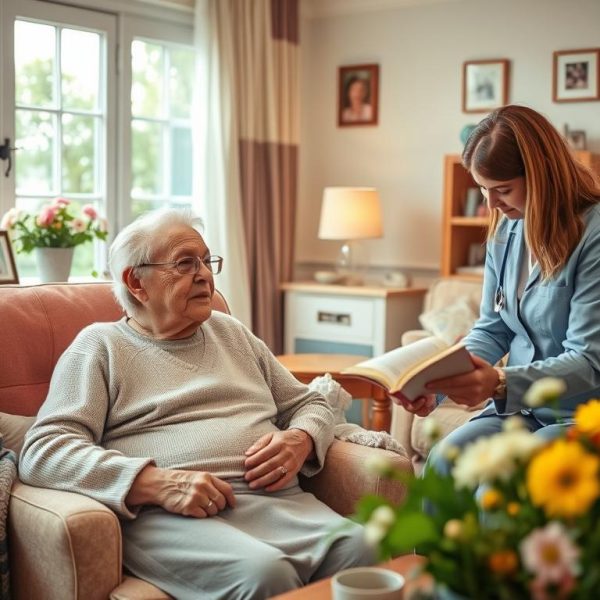Chapter 1: The Beginning of a New Chapter
Meet Ellen, a spirited 78-year-old who had always loved to dance. Her home was filled with memories of lively gatherings and graceful twirls. But recently, Ellen’s heart had started to show signs of fatigue. Diagnosed with heart disease, her once vibrant lifestyle seemed to be dimming.
Enter Sam, a compassionate caregiver with a knack for making each day brighter. When Sam first began working with Ellen, he knew his role went beyond just providing physical assistance. He was there to support Ellen in maintaining her quality of life and managing her heart condition with care and understanding.
Chapter 2: Crafting a Heart-Healthy Routine
Sam’s journey with Ellen began with a careful assessment of her needs. He collaborated with Ellen’s healthcare team to understand her specific condition, medication regimen, and dietary restrictions. This personalized approach was crucial in designing a care plan that balanced Ellen’s heart health with her love for life.
Every morning, Sam prepared Ellen’s breakfast with heart-healthy ingredients—oatmeal, berries, and nuts. He knew that a proper diet was essential for managing heart disease. But he didn’t stop there. Sam also made sure Ellen took her medications on time and monitored her blood pressure regularly.
Chapter 3: The Importance of Physical Activity
Exercise was a vital part of Ellen’s daily routine, but it had to be adapted to her condition. Sam incorporated gentle exercises into Ellen’s day, such as chair yoga and walking around the garden. These activities were not just about physical health; they were also a way for Ellen to reconnect with the joy she once felt in dancing.
Sam understood that while staying active was important, it was equally crucial to ensure that Ellen didn’t overexert herself. He always kept a close watch on Ellen’s responses to physical activity, adjusting the intensity based on how she felt. This balance between activity and rest was key to managing her heart disease effectively.
Chapter 4: Emotional Support and Companionship
Heart disease can often bring about feelings of isolation and anxiety. Sam knew that Ellen’s well-being extended beyond physical care. He spent time listening to Ellen’s stories, engaging in activities she enjoyed, and simply being a comforting presence.
One afternoon, Ellen shared a memory of a dance performance she once gave. Sam, understanding the significance of this memory, organized a mini “dance party” in the living room, complete with Ellen’s favorite tunes. It was a simple gesture, but it brought a smile to Ellen’s face and reminded her of the joy she still carried within.
Chapter 5: Navigating Challenges with Care
Managing heart disease often involves navigating various challenges, from fluctuating symptoms to adjusting lifestyle habits. Sam was always prepared to adapt Ellen’s care plan as needed. Whether it was handling a sudden change in Ellen’s condition or coordinating with healthcare providers, Sam’s proactive approach ensured that Ellen received the best possible care.
He also educated Ellen about recognizing symptoms that might require immediate medical attention, such as chest pain or shortness of breath. Empowering Ellen with this knowledge helped her feel more in control of her condition and less anxious about potential emergencies.
Chapter 6: Building a Support Network
Sam recognized that caring for Ellen involved more than just his efforts; it required a collaborative approach. He liaised with Ellen’s family to keep them informed about her progress and any changes in her condition. Regular updates and open communication helped build a strong support network around Ellen.
Involving family members also meant that they could participate in Ellen’s care, from attending medical appointments to sharing in daily routines. This holistic approach not only provided Ellen with comprehensive support but also ensured that her family felt connected and involved.
Chapter 7: Looking Forward with Hope
As the months passed, Ellen’s health improved, and her spirits were lifted. Sam’s thoughtful care had not only managed Ellen’s heart disease but had also enriched her quality of life. Ellen continued to enjoy her activities, albeit in a modified way, and remained engaged with her passions and loved ones.
For Sam, the journey with Ellen was a reminder of the profound impact caregivers can have on the lives of those they serve. It was about more than just managing a condition; it was about fostering a sense of hope, joy, and connection.
Conclusion: A Heartfelt Legacy
In caring for seniors with heart disease, caregivers like Sam play a crucial role in enhancing their well-being and quality of life. By providing personalized care, emotional support, and practical assistance, they help their clients navigate the challenges of heart disease while embracing the joys of living.
For caregivers, paying attention to both the physical and emotional needs of seniors is essential. It’s about crafting a care plan that supports their health, encourages positive experiences, and fosters a sense of hope and connection. As we celebrate the dedication of caregivers like Sam, we also acknowledge the resilience and spirit of seniors like Ellen, who continue to inspire us all.








